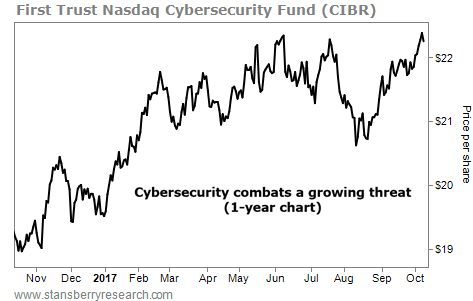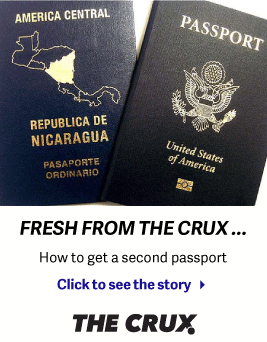| Home | About Us | Resources | Archive | Free Reports | Market Window |
How to Do Even Better Than 'Dazzling' GainsBy
Wednesday, October 11, 2017
Imagine you're on a game show and the host holds out two envelopes...
"Each envelope offers you a 50% chance to win money," he says. "You'll have a 50% chance to win $10,000 if you choose the one in my left hand. And you'll have a 50% chance to win $30,000 if you choose the one in my right hand. Which will it be?"
You reach for the $30,000 envelope. You open it up, and learn that you didn't win...
"I'm so sorry," he says. "You now owe us $15,000."
"What? I didn't agree to that."
"Yes, you did. You chose to participate. The $30,000 envelope carried the chance of losing 50% of that amount. But had you won, you would have gotten $3,000 a year for the next 10 years."
"Are you kidding? That's a terrible deal. What could I have lost with the other envelope?"
"Just 5%, or $500. And the $10,000 payout would have been paid to you in one month," he added. "Why didn't you ask any questions beforehand?"
You storm off-camera enraged, as the folks in the audience shake their heads.
OK... Maybe this game show wouldn't make it on air. But this sort of thing plays out in the market every day.
People are dazzled by big numbers... And they ignore almost everything else.
Today, I want to show how you can use three different metrics to better measure and understand your trades...
Investors and traders like to talk in percentages rather than in dollar amounts. That's because the significance of $10,000, for example, depends on the size of the portfolio. But everyone knows what a 100% gain means. It means doubling your money.
The thing is, percentage gains need context, too...
If someone tells you he made 300% on an investment, your first reaction might be amazement or jealousy. But what did he risk to make that 300%?
If he was willing to lose 100% of his investment, it's still a good return. But it's nothing compared with the same return on a position with just 20% at risk.
That's because – if you know you're risking 100% – you won't invest nearly as much. If you're willing to lose $300, you'll only put in $300. So a 300% gain means you would make $900.
But if you're willing to lose $300 on a position that risks just 20% of your capital, you can invest $1,500. ($1,500 x 20% = $300.) A 300% gain on this investment means you would make $4,500.
The return is 300% either way. And the money at risk is $300 either way. But the "reward to risk ratios" for the two investments are different...
The first one has a reward-to-risk ratio of 3-to-1 (a 300% reward divided by a 100% risk). The second has a reward-to-risk ratio of 15-to-1 (a 300% reward divided by a 20% risk).
The reward-to-risk ratio should be the first thing that pops into your mind when you think about successful trades. Steve Sjuggerud likes to use a 3-to-1 ratio as a guideline. I do the same in my DailyWealth Trader (DWT) newsletter.
In my nearly five years at DWT, I'm most proud of our position in gold miner Newmont Mining (NEM)...
I'm proud not only because we're up 135%... but because we risked just 10% to achieve that return. We're up nearly 14 times our initial risk. That's a fantastic trade... And it could continue to grow.
Not far behind Newmont is our position in sparkling-water maker National Beverage (FIZZ). On this position, we're up 116% and we risked 17%. That's a return of nearly seven times our risk. And we've only held the position for eight months...
The next metric you should use to measure your trades is annualized returns. We've been holding Newmont for a little more than two years now. So the 135% return comes to about 66% per year, so far... a 66% annualized return.
Since we've held National Beverage for only about eight months, the 116% return comes to a 170% annualized return. That's spectacular... and almost three times the annualized return on our Newmont trade.
I personally put a higher value on reward-to-risk ratios than I do on annualized returns. But you could easily make the case that National Beverage is the better trade.
Finally, you need to consider the likelihood of a gain versus a loss...
From this perspective, I would have to say our position in consumer-electronics giant Apple (AAPL) is our best trade ever in DWT. We're up 66% and we risked 25%... So our reward-to-risk currently stands at just 2.7. And we have held the position for 20 months... So the annualized return is just 41%. But Apple was so cheap – and so strong of a business – that I would have put the likelihood of taking a loss on that position at next to nothing.
It was the least risky position we've ever taken in DWT. A 66% gain on such a safe position is rare.
To summarize, big percentage gains are great. They look good and feel good. But they're not all that important...
If we made a trade tomorrow with 2% downside risk and booked a 40% gain in a year, it would be our best trade ever, hands down. The 20-to-1 reward-to-risk ratio would knock all three positions above out of the running.
You could risk $300 and make $6,000. On a trade like that, who cares about the 40% figure? Not me... And you shouldn't either.
The next time someone brags to you about making a big percentage gain, ask how much he risked. Ask how long it took him to make that return. And maybe even ask how confident he was it would be a winner.
Only then will you have the full story. Only then will you know if it was a good trade.
Good trading,
Ben Morris
Further Reading:
Earlier this year, Ben explained exactly how to use risk-to-reward ratios in your exit strategy. It should be part of your overall trading plan... And it can save you from a simple – but costly – mistake. Learn more here: The Most Important Question You Need to Ask Yourself Today.
Market NotesEVERY BUSINESS FACES THIS BIG PROBLEM Today's chart highlights a major concern for modern businesses...
Regular readers know we are always looking to invest in big secular trends. Today, one of these trends is the security of personal data stored on the Internet. It's much easier to buy your coffee with a smartphone, or to save your credit card on Amazon (AMZN) for your purchases. But sending and saving your information online has consequences...
Last month, we learned that credit-reporting bureau Equifax (EFX) was hacked. The personal information of about 145 million Americans was stolen, including social-security and credit-card numbers. As attacks like this keep increasing, big businesses will turn to cybersecurity experts for help. Today, we can see this concept at work in shares of the First Trust Nasdaq Cybersecurity Fund (CIBR)...
CIBR holds shares of leading cybersecurity firms like Symantec (SYMC) and Palo Alto Networks (PANW). As you can see in the chart below, the fund has surged higher after the recent data breaches. Shares are up 14% from last year, and they just hit a new all-time high. Expect more businesses to turn to cybersecurity experts as these hacks worsen...
 |
Recent Articles
|



